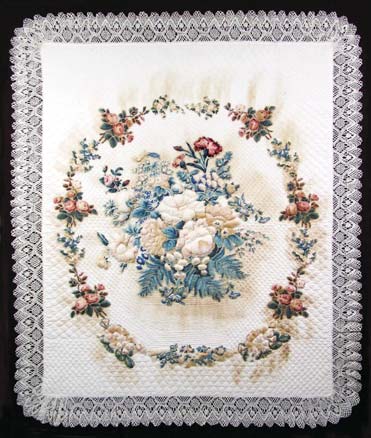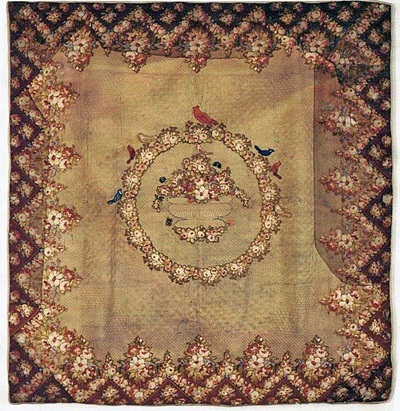One would think that quilts, like paintings, hang on walls forever, immune to the passage of time. Unfortunately, like any other item exposed to the elements, quilts begin to deteriorate. Conserving textiles can be complicated, and the preservation story of these two at the First White House of the Confederacy is an amazing one.
With the encouragement from Montgomery quilt expert and author Mary Elizabeth Johnson Huff and former White House Association of Alabama Regent, Cameron Freeman Napier, the First White House of the Confederacy agreed to participate. The White House Association, by a 1901 act of the Alabama Legislature and subsequent legislation, is responsible for the artifacts and relics in the First White House of the Confederacy, the home in which Confederate Pres. Jefferson Davis and his family lived during the spring of 1861. The decision to lend the quilt to the American Textile History Museum brought with it obvious concern because the quilt, made prior to 1862, was in extremely poor condition. When the quilt reached the American Textile History Museum, the museum experts were quick to turn to Con- Text Inc. in Rochester, Massachusetts, a company noted for textile conservation. The employees at ConText Inc. subsequently contacted the First White House about conserving the quilt, sending a condition report listing all the damaged areas and the treatment recommendations of what must be done to save the quilt. Knowing this was a good opportunity to preserve the quilt, the First White House asked them to begin work as soon as possible so that the quilt would be ready for the exhibition.
Treatment included binding the beige bias, fixing previous repairs, removing the muslin backing, and stabilizing and vacuuming the quilt edges. The edges were bound with bias-cut strips of nylon tulle, stitched in place along the original green silk binding seamline. Dyed cotton underlays were added at the lower corners. After the edges were stabilized, the face and reverse were vacuumed. A seamless cotton fabric backing was stitched to the quilt using a diagonal grid-work of running stitches through all layers of the quilt. The stitch pattern was altered to work around the central “wreath” motif and stuff ed floral border areas. Stabilizing overlays of dyed nylon tulle were stitched to the most damaged areas of the quilt face. Many previous stitched repairs were left intact because they were not putting additional stress on the quilt and because they represent part of the history of the quilt.
The origin of the Gunboat Quilt and the Baby Quilt at the First White House of the Confederacy is a mystery. Historians know they were made by the same person, but the question lingers about who this person actually was.
But that’s only the first part of the story. The success of the Gunboat Quilt conservation prompted us to make overtures to ConText about the condition of the Baby Quilt. The Baby Quilt, made by the same seamstress and also prior to 1862, was in a frame and had extensive brown staining on the background due to water damage. Unfortunately, the condition of the quilt limited conservation options. In fact, Kathryn Tarleton, conserver, wrote in a report, “This is an instance where not treating the object is actually in its best interest.”
But a few weeks later, Tarleton explained that she was not satisfied with the conclusion at which she had arrived and felt there must be another solution to the problem. She proposed a new course of action to save the quilt. It was removed from its original frame, and the mount fabric was mechanically separated from the Masonite mount board using a thin spatula. The mount fabric was cut away from the reverse of the quilt in the areas without glue. The areas with glue were humidified to soften the glue bond and then mechanically removed using a small spatula. Some traces of glue remained, and the quilt was carefully surface cleaned with a low suction vacuum. It was then wet cleaned to remove soluble soils and reduce staining and allowed to dry. In order to make the remaining stains less visible, various bleaching treatments were considered, and the best one was applied. Though it did not completely remove the stains, the chosen treatment reduced them significantly. The overall appearance of the quilt was transformed dramatically, all for the better.
The newly conserved Baby Quilt hangs in the upstairs hall of the First White House of the Confederacy, just outside the nursery, where it has been reframed and is protected from the sunlight. The Gunboat Quilt continues to tour the country, and a listing of exhibit locations can be found in the extra resources for this article on AlabamaHeritage.com. For more information about the Gunboat Quilt, see Alabama Heritage, Issue 8, Spring 1988.
This article was originally published in Alabama Heritage Issue #113, Summer 2014.
Author
Anne Henry Tidmore, who graduated from Huntingdon College with a BA in English and history, became the Regent for the White House Association of Alabama in 2009, the organization formed in 1900 to save the First White House of the Confederacy in Montgomery. She writes a blog and is in the process of writing a book about the First White House of the Confederacy. She began Tidmore Flags, a retail and mail order flag business in Birmingham in 1964 and retired in 2001.


 RSS Feed
RSS Feed